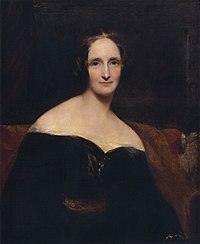 |
| €1 in Mitchelstown on 28th Nov |
Whiling away a spare half hour before my bus to Cork last week, l bought a battered copy of Mary Shelley’s
Frankenstein in a charity shop. I decided to familiarise myself with this iconic work.
Here's what happens. The young Swiss Victor Frankenstein growing up in Geneva develops a passion for natural philosophy and chemistry and enrols as a student at the university. There he becomes consumed by the desire to discover the secret of life and after several years of research, attains the knowledge he seeks.
For months he feverishly and clandestinely fashions a creature out of old body parts and strange chemicals. One climactic night, he brings his creation to life. But the monstrosity he has made horrifies him. He flees the scene. Sickened by his disgusting deed he falls dangerously ill.
On recovery he returns to Geneva, to his family, and he hopes, to his old life. But the monster dogs his steps, and over the course of the book commits four murders. The first of these is Victor Frankenstein’s little brother. The second is when the monster cleverly contrives a miscarriage of justice so that the kind, gentle Justine, a sort of adopted cousin, is tried for the murder, condemned, and executed,
Only Victor knows of the monster’s existence, which he dare not divulge.
Overcome by grief and remorse, he flees to the Alps. Here the monster (sometimes called a dæmon, sometimes a fiend) tracks him down, and here we would expect the monster to kill him, end of book. But no, the monster whilst admitting to the murders, begs for understanding.
It emerges that the monster has previously attempted to befriend human kind but has been rebuffed due his hideous appearance, and so travels at night and hides in dark places, seeking revenge on Frankenstein. Lonely, shunned, and forlorn, he says that he struck out at Victor’s little brother in a desperate attempt to injure Victor, his cruel creator. The monster begs Victor to create a mate for him, a female monster equally grotesque, to serve as his sole companion.
Creating another monster
Appalled at the prospect of creating a second monster Victor at first refuses. But the monster is eloquent and persuasive, and eventually Victor is convinced.
After many delays (reminiscent of Hamlet, perhaps) Victor secludes himself on a desolate island in Orkney and reluctantly works at his ghastly task. One night, consumed by doubts about the morality of his actions, Victor perceives the monster glaring in at him through a window with a horrid grin. Alive for the first time to the awful consequences of his work, Victor destroys his new creation.
Whereupon the enraged monster vows revenge, and swears that he will be with Victor on his wedding night. After more adventures, and another murder (of Victor’s friend Henry) Victor returns home to Geneva, where he marries his cousin and childhood sweetheart Elizabeth. Whom, true to his word, the monster murders on their wedding night.
Like Moby Dick
Vowing to devote the rest of his life to finding the monster and exacting his revenge, Victor tracks him ever northward into the arctic ice. His obsessive pursuit puts one in mind of Captain Ahab pursuing the great white whale, a parallel Melville surely had very much in mind.
In a dogsled chase, Victor almost catches up with the monster, but the sea beneath them swells and the ice breaks, leaving an unbridgeable gap between them. At this critical moment, Victor Frankenstein is saved by the crew of an arctic exploration vessel, but after some days expires of exhaustion. Not however before he has told the ship's captain Walton his entire story.
Later Walton is startled to find the monster weeping over Victor’s body. To Walton the monster confides his immense solitude, suffering, hatred, and remorse. He asserts that now his creator is dead, he too can end his suffering. The monster then departs for the northernmost ice to die.
I've put an edited version of the book’s last four pages in this
pdf file.
 |
Mary Shelley (née Mary Wollstonecraft Godwin)
1797–1851 |
Nested narratives
The novel’s structure is the nested narrative, like the Arabian Nights. The arctic explorer Walton’s letters to his sister back in England envelop the entire tale. Victor’s story fits inside Walton’s letters. The monster’s story fits inside Victor’s. And there's more nesting that I won't go into here.
Who is most monstrous?
Eight feet tall and hideously ugly, the monster is rejected by society. His monstrosity resides not only in his grotesque appearance but also from the unnatural manner of his creation. One commentary I've seen suggests that there are a number of monstrous entities in the novel, of which the monster is only the most literal.
There's the dangerous knowledge that Victor employs to create the monster. And then there's Victor himself - is he a kind of monster. Ordinary on the outside, his ambition, secrecy, and selfishness alienate him from human society, and at last he's consumed by obsessive hatred of his creation.
Finally (it says here), many critics have described the novel itself as monstrous, a stitched-together combination of different voices, texts, and tenses (see nesting above.)
A classic




